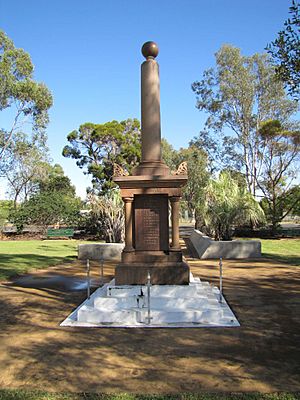Mitchell War Memorial facts for kids
Quick facts for kids Mitchell War Memorial |
|
|---|---|

Mitchell War Memorial, 2013
|
|
| Location | Cambridge Street, Mitchell, Maranoa Region, Queensland, Australia |
| Design period | 1919 - 1930s (interwar period) |
| Built | 1927 |
| Architect | Andrew Lang Petrie and Son |
| Official name: Mitchell War Memorial | |
| Type | state heritage (built) |
| Designated | 21 October 1992 |
| Reference no. | 600038 |
| Significant period | 1927- (social) 1920s (historical) 1927 (fabric) |
| Significant components | memorial surrounds/railings, memorial/monument |
| Builders | Andrew Lang Petrie |
| Lua error in Module:Location_map at line 420: attempt to index field 'wikibase' (a nil value). | |
The Mitchell War Memorial is a special monument in Mitchell, Queensland, Australia. It is listed on the Queensland Heritage Register, which means it's an important historical place. This memorial was built in 1927 by a company called Andrew Lang Petrie and Son. It stands on Cambridge Street and helps us remember the people from the area who served in wars.
Remembering Our Heroes
The Mitchell War Memorial was officially opened in 1927. It was made by A L Petrie and Son, a company from Brisbane that made many monuments. This memorial honors 51 local people who died in the First World War. The local community raised £464 to pay for it, which was a lot of money back then!
Mitchell became an important town in the late 1800s. It was a central place for the surrounding farming areas. The railway line reached Mitchell in 1885, making it even more important.
Before the First World War, Australia didn't have many public monuments. But after the war, memorials became very important. They showed how much the war affected the country. Australia lost about 60,000 soldiers from a population of only 4 million. This meant one out of every five Australians who fought in the war died. No other war has had such a big impact on Australia.
Even before the war ended, people started building memorials. These monuments were like sacred places. They were substitute graves for soldiers whose bodies were buried overseas. The word "cenotaph" means "empty tomb." This is because the soldiers were buried where they fell, not brought home.
Australian war memorials are special because they don't just remember the dead. They also honor everyone who served from a local area. Australians were proud that their army was made up entirely of volunteers. These memorials show how much communities were involved in the war effort.
These memorials also show what people valued at the time. They highlight the skills of local stonemasons and architects. In Queensland, statues of soldiers, often called "diggers," were very popular. In southern states, tall, pointed monuments called obelisks were more common.
Many First World War memorials have been updated to include later conflicts. Some have even been moved or repaired over time. The Mitchell War Memorial has a unique design. It is the only one of its kind in Queensland. A L Petrie and Son, who made it, were the biggest monument makers in Queensland at the time.
What the Memorial Looks Like
The First World War Memorial is in a park. It has a fence around it made of cast iron posts with fancy tops.
The memorial itself is made of sandstone and granite. It sits on a concrete base with steps. The iron fence posts are set into the bottom step. Above this is a smooth step with a curved top edge. On the front of this step, it says: "Their Name Liveth Forever More."
Above this step is another smooth section. It has a sloped part in the middle of each side. The corners are flat and hold up four columns. These columns have special tops called Doric order capitals. They surround red polished granite plates. These plates have an inscription and the names of the 51 local soldiers who served in the First World War. Their names were originally cut into the stone and covered in gold. The top of the front plate has an AIF badge.
The four columns hold up a large top section called an entablature. This part has a smooth front and a curved molding at the top. Each corner has a large decorative piece called an acroterion. In the middle of the top section is a red granite column. It sits on a square base and has a simple bottom. It doesn't have a fancy top, but it's capped with a polished red granite sphere, which looks like a ball.
Why This Place is Important
The Mitchell War Memorial was added to the Queensland Heritage Register in 1992. This means it's very important for several reasons:
- It shows Queensland's history: War memorials show a common part of Queensland's history. They remind us of a time when people felt very patriotic, especially after the First World War. They are a unique record of that time and show what was popular in design.
- It's a rare design: This memorial has a very unusual design. It is the only one of its kind in Queensland, making it very special.
- It shows what memorials are like: Built in 1927, this memorial is a great example of a monument built to remember a big historical event. Its design and materials help it stand as a lasting memory.
- It's beautiful: The memorial is important because it's well-made and designed. It uses good materials and looks impressive.
- It's important to the community: This memorial has a strong connection with the local community. It helps people remember the impact of a major historical event. It is a central place for remembering those who served.
- It shows special workmanship: The memorial also shows the excellent work of the monumental masonry company, A L Petrie and Son.

